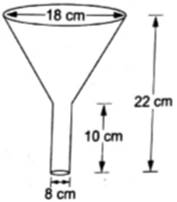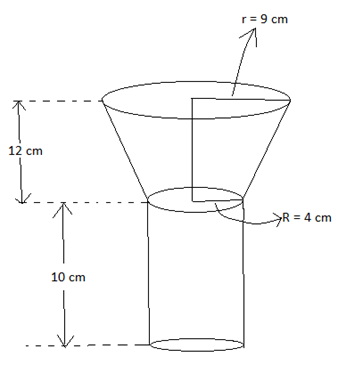An oil funnel made of tin sheet consist of a 10 cm long cylindrical portion attached to a frustum of a cone. If the total height is 22 cm, diameter of the cylindrical portion is 8 cm and the diameter of the top of the funnel is 18 cm, find the area of the tin sheet required to make the funnel.


Divide the funnel into two parts frustum and cylinder as shown in the figure
Parameters of frustum:
Diameter of upper circular end = 18 cm
∴ Radius of upper circular end = r = 18/2 = 9 cm
The radius of cylinder is equal to the radius of lower circular end of frustum
∴ radius of lower circular end = R = 4 cm
Height of frustum = total height – height of cylinder
= 22 – 10
= 12 cm
∴ height of frustum = h = 12 cm
Total surface area of frustum = πr2 + πR2 + π(R + r)l cm2
Where l = slant height
![]()
![]()
∴ l = 13 cm
Since for the frustum part of the funnel we don’t require the upper circular end and the lower circular end hence we need to subtract those areas from total surface area.
Area of upper circular end = πr2
Area of lower circular end = πR2
total surface area = πr2 + πR2 + π(R + r)l- πr2- πR2
= π(R + r)l
= 3.14 × (9 + 4) × 13
= 530.66 cm2
∴ total surface area of frustum for which tin is required = 530.66 cm2
Parameters of cylinder:
Height of cylinder = 10 cm
Radius of cylinder = 4 cm
∴ Area of tin require to make cylinder = 2π × (radius) × (height)
= 2 × 3.14 × 4 × 10
= 251.2 cm2
∴ Area of tin required to make the funnel = area of frustum for which tin is required + area
of tin require to make cylinder
∴ area of tin required to make funnel = 530.66 + 251.2
= 781.86 cm2
∴ Area of tin sheet require to make the funnel = 781.86 cm2